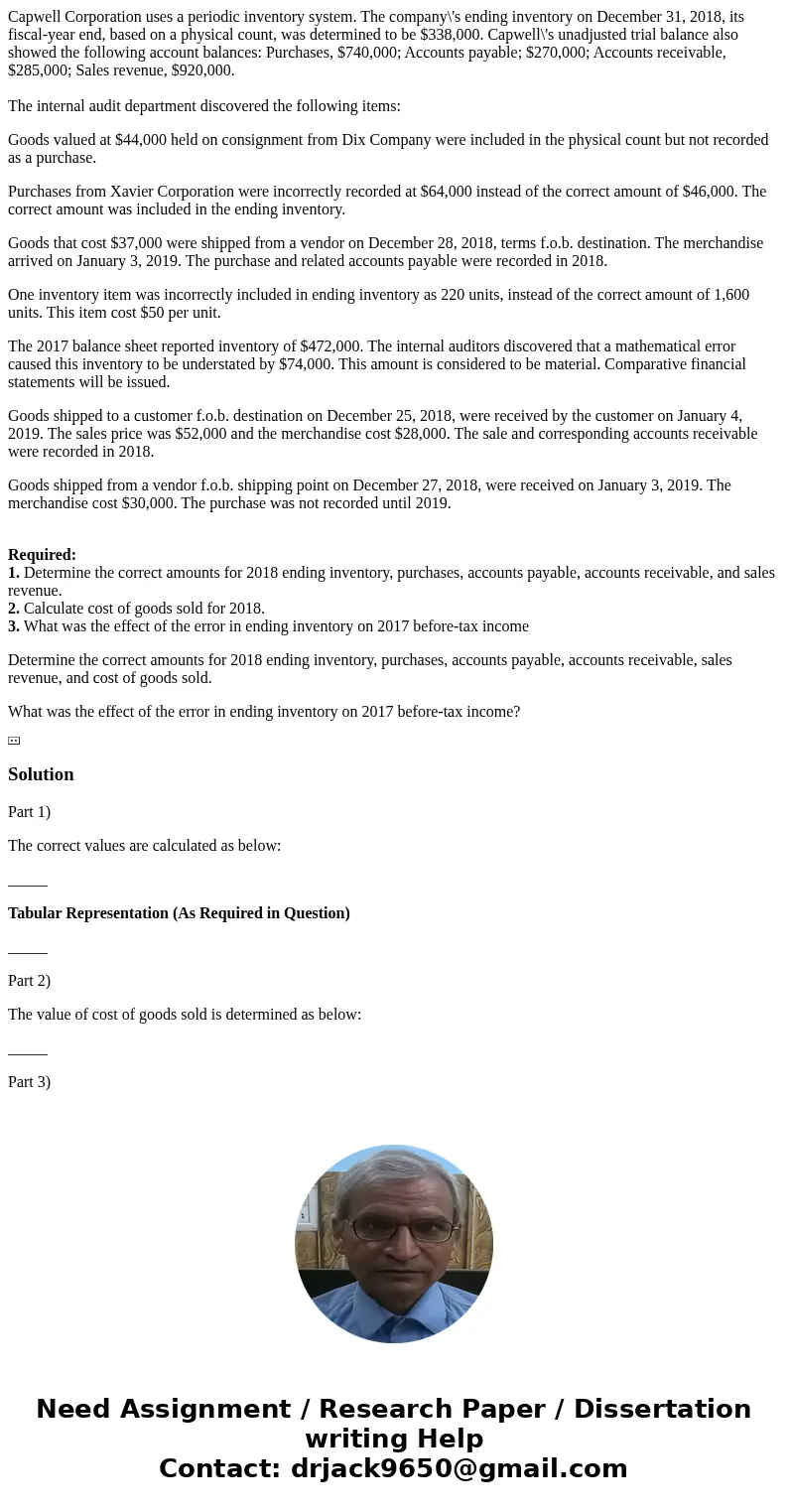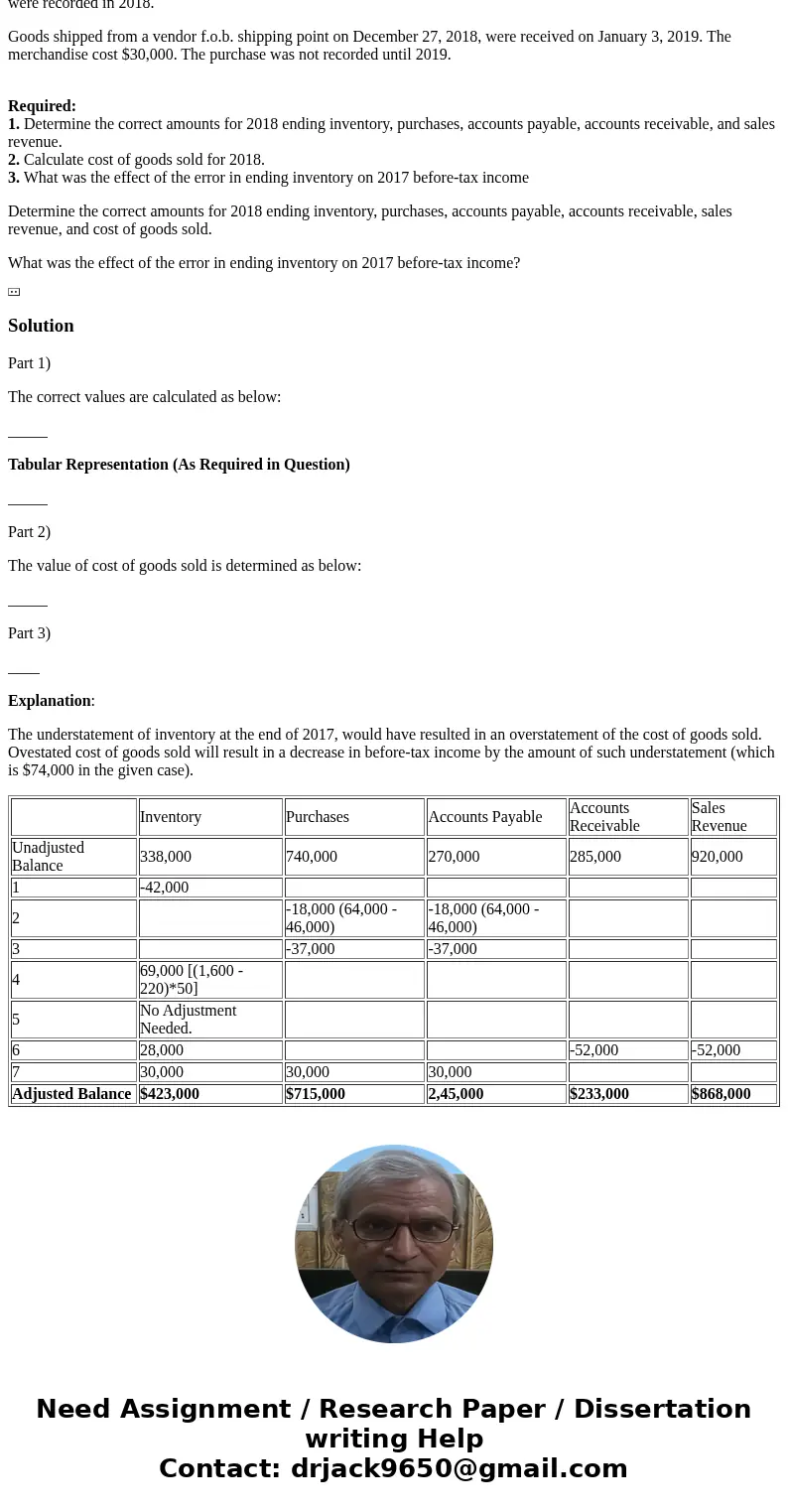Capwell Corporation uses a periodic inventory system The com
Capwell Corporation uses a periodic inventory system. The company\'s ending inventory on December 31, 2018, its fiscal-year end, based on a physical count, was determined to be $338,000. Capwell\'s unadjusted trial balance also showed the following account balances: Purchases, $740,000; Accounts payable; $270,000; Accounts receivable, $285,000; Sales revenue, $920,000.
The internal audit department discovered the following items:
Goods valued at $44,000 held on consignment from Dix Company were included in the physical count but not recorded as a purchase.
Purchases from Xavier Corporation were incorrectly recorded at $64,000 instead of the correct amount of $46,000. The correct amount was included in the ending inventory.
Goods that cost $37,000 were shipped from a vendor on December 28, 2018, terms f.o.b. destination. The merchandise arrived on January 3, 2019. The purchase and related accounts payable were recorded in 2018.
One inventory item was incorrectly included in ending inventory as 220 units, instead of the correct amount of 1,600 units. This item cost $50 per unit.
The 2017 balance sheet reported inventory of $472,000. The internal auditors discovered that a mathematical error caused this inventory to be understated by $74,000. This amount is considered to be material. Comparative financial statements will be issued.
Goods shipped to a customer f.o.b. destination on December 25, 2018, were received by the customer on January 4, 2019. The sales price was $52,000 and the merchandise cost $28,000. The sale and corresponding accounts receivable were recorded in 2018.
Goods shipped from a vendor f.o.b. shipping point on December 27, 2018, were received on January 3, 2019. The merchandise cost $30,000. The purchase was not recorded until 2019.
Required:
1. Determine the correct amounts for 2018 ending inventory, purchases, accounts payable, accounts receivable, and sales revenue.
2. Calculate cost of goods sold for 2018.
3. What was the effect of the error in ending inventory on 2017 before-tax income
Determine the correct amounts for 2018 ending inventory, purchases, accounts payable, accounts receivable, sales revenue, and cost of goods sold.
What was the effect of the error in ending inventory on 2017 before-tax income?
Solution
Part 1)
The correct values are calculated as below:
_____
Tabular Representation (As Required in Question)
_____
Part 2)
The value of cost of goods sold is determined as below:
_____
Part 3)
____
Explanation:
The understatement of inventory at the end of 2017, would have resulted in an overstatement of the cost of goods sold. Ovestated cost of goods sold will result in a decrease in before-tax income by the amount of such understatement (which is $74,000 in the given case).
| Inventory | Purchases | Accounts Payable | Accounts Receivable | Sales Revenue | |
| Unadjusted Balance | 338,000 | 740,000 | 270,000 | 285,000 | 920,000 |
| 1 | -42,000 | ||||
| 2 | -18,000 (64,000 - 46,000) | -18,000 (64,000 - 46,000) | |||
| 3 | -37,000 | -37,000 | |||
| 4 | 69,000 [(1,600 - 220)*50] | ||||
| 5 | No Adjustment Needed. | ||||
| 6 | 28,000 | -52,000 | -52,000 | ||
| 7 | 30,000 | 30,000 | 30,000 | ||
| Adjusted Balance | $423,000 | $715,000 | 2,45,000 | $233,000 | $868,000 |


 Homework Sourse
Homework Sourse